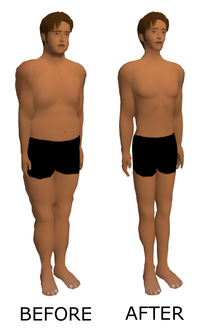
Photo from wikipedia
Endoscopic bariatric and metabolic therapies are promising for obesity. We developed a novel gastro-duodenal flow restrictor (G-DFR) device for relative weight loss and lowering of glucose level and evaluated its… Click to show full abstract
Endoscopic bariatric and metabolic therapies are promising for obesity. We developed a novel gastro-duodenal flow restrictor (G-DFR) device for relative weight loss and lowering of glucose level and evaluated its safety and efficacy in a porcine model. The G-DFR comprised self-expandable gastro-duodenal partially covered polytetrafluoroethylene (PTFE) metal stent distally attached to a PTFE skirt. Eleven juvenile pigs were randomized into the evaluation of migration (n = 3), mid-term efficacy (n = 5), and control (n = 3) groups. Five pigs showed G-DFR migration at 2, 4, 7, and 10 weeks after placement in the migration and mid-term efficacy group. Compared to the control group, the mid-term efficacy group showed up to 55.4% relative weight loss in 12 weeks. Compared to the case group, the control group showed higher mean ghrelin hormone level from 6 to 12 weeks. Glucose level was significantly lower in the efficacy group than in the control group after 6 weeks. Serum alanine transferase levels and histological collagen deposition were lower in the liver of the case group than in the control group. Although it did not demonstrate consistent performance with respect to migration, a well-positioned G-DFR in the pyloroduodenal portion may lead to relative weight loss, lowering of glucose levels, and improved hepatic parameters.
Journal Title: Nutrients
Year Published: 2022
Link to full text (if available)
Share on Social Media: Sign Up to like & get
recommendations!